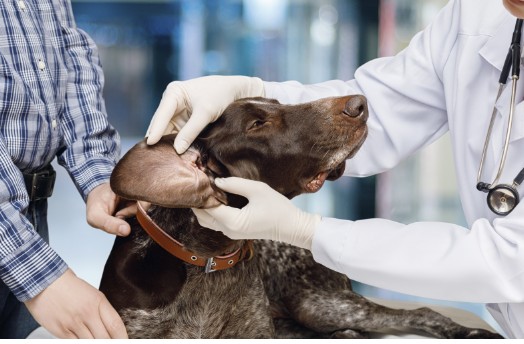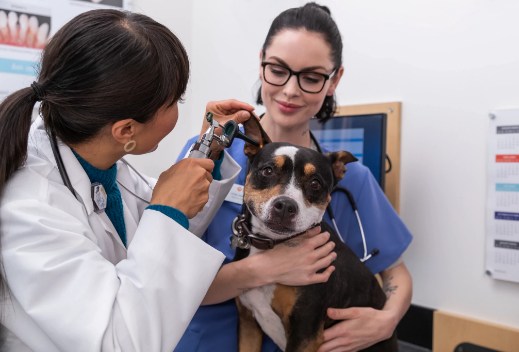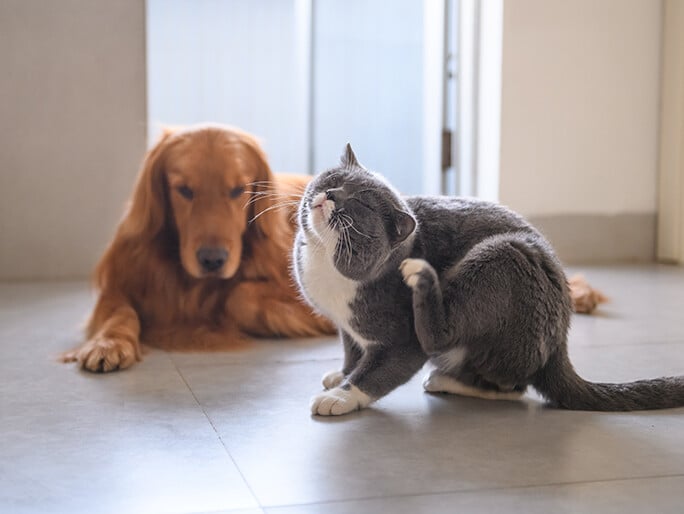ear yeast infections in dogs
Leaky dog ear canals that smell like bread, beer, or feet may mean otitis externa.
Natural yeast on dog ears and skin can go wild and cause a fungal ear infection.

Dog ear infection symptoms
- Head shaking and ear scratching
- Yeasty, beery, or foot-like ear odor
- Greasy and smelly brown or gray ear discharge
- Rubbing ears against floors or furniture
- Hair loss from ear scratching
- Affected ear droops lower than the other
- Loss of hearing and balance
Yeast is the most common cause of outer ear infections in dogs
Your dog naturally has a kind of skin yeast, Malassezia pachydermatis, that can invade the ear canal and cause a full-blown ear infection.

The difference between outer ear infections and inner ear infections
Ear infections are one of the most common dog diseases, but they come in a few shapes and sizes.
Most yeast ear infections start in your dog’s outer ear, which is called otitis externa. If that infection isn’t treated quickly, it can spread to the middle ear (otitis media) and inner ear (otitis interna) and become much more difficult to treat.
Middle and inner ear infections can also cause long-term ear damage from constant inflammation and damage to delicate ear tissues. If your dog’s ears look or smell funny, please bring them to see the vet.
Why do dogs get ear infections?
Some dogs are unfortunately prone to chronic yeast ear infections. One culprit is long, floppy ears that can trap moisture, while another is food and environmental allergies that can inflame the skin inside dog ears and trap moisture there.

In addition to causing general inflammation, allergies cause ear itchiness and scratching that can cause secondary infections.

Swimming, heat, or humidity can cause extra moisture in the ear, especially if your dog’s ear flap usually covers the ear canal.

Anything that blocks the ear canal, including seeds, grass, ear wax, and ear discharge, can lead to a yeast infection.
Ear mites are tiny little spider-like bugs that can infest dog ear canals, causing itchiness and inflammation that can lead to infection.
How to treat yeast ear infections in dogs
Please get your doggyBFF’s ears checked out by your vet! Many home “remedies” found on the internet can actually make yeast ear infections worse.
What can the vet do to help treat yeast in the ear?
At your appointment, we’ll ask a few questions to help us figure out how to help your pet. Let us know when you first noticed your dog’s symptoms, if you think something might be in their ear, and if your dog is a big swimmer. We’ll also ask if they’ve had other ear infections or have been diagnosed with allergies.
Once we have a diagnosis, we’ll prescribe the appropriate treatment. This usually involves a few weeks of cleaning your dog’s ears and then applying a topical antifungal treatment. Sometimes we’ll do a cleaning and med application right there at the office. Ask as many questions as you need! We’re here to help.
We’ll provide step-by-step instructions on how to use your vet-approved ear cleaner and antifungal prescription. Call us with any questions or concerns. Ear infections can be stubborn, so we’ll typically recommend a recheck to make sure your dog’s ears are on the mend.
Tips for ear yeast infection prevention
Your veterinary team is a great resource in trying to help your dog avoid future yeast infections. Depending on their needs, we may recommend that you regularly clean their ears and give you tips on how to do it safely.
- If your pet loves to swim: Always dry the outside of their ear canal with a few cotton balls after they get out of the water (and maybe wait until after they shake to avoid getting drenched).
- If you’re in hot and humid areas: Try checking and blotting your pup’s ears. You can also try keeping long ear hair clipped; many groomers can do this for you.
- If your pup has underlying conditions like a food or environmental allergy: Your veterinary team can help diagnose the problem and work with you to help your pet be more comfortable. Managing inflammation and itchiness caused by allergies can be a big help for dog ears.
Mentioned in this article

Treating dog ear infections without a vet
What to know about popular home remedies.

A guide to pet food allergies
Ingredients and symptoms to look out for.

Does your dog have ear mites?
What "coffee grounds" in ears might mean.

Need advice on flea control? Ping Pet Chat™!
Whether it's 3 a.m. or 3 p.m., connect with a real veterinary professional for immediate petcare advice. It's included in all Optimum Wellness Plans®!
Log in to start chattingHow Banfield can help with ear care for cats and dogs
We take happy, healthy pet ears seriously! Our vets can help you find out what’s causing your pet’s ear issues, work with you on a treatment plan, and prescribe safe and effective medications to help treat your pet. We can even work with you to help prevent future problems.

We can work with you to help manage chronic ear infections. If you notice your pet is getting ear infection after ear infection, let’s discuss underlying causes, solutions, and possible prevention for your pet’s issues.
We can provide guidance for cleaning and medicating dog and cat ears. Infected ears can be tender, which may make it rough to treat them at home. Let us know if your pet absolutely refuses to cooperate — we’re here to help!
We can help identify and manage food or environmental allergies that can cause ear infections and skin itchiness and irritation. If you suspect an allergy is causing your pet to sneeze, wheeze, itch, or scratch, we’re here with professional guidance to help your pet.
Any other health concerns?
Just let us know. We’re here to help with loving veterinary care, including your pet’s adorable ears.
 Mites and mange
Mites and mange Podcast - Not Just Fluff
Podcast - Not Just Fluff



